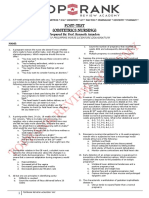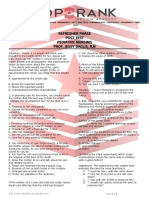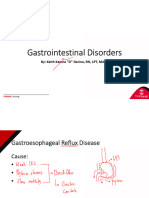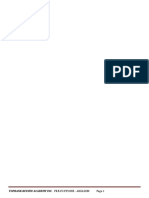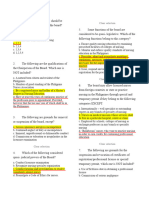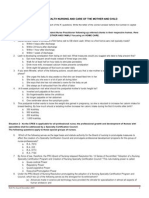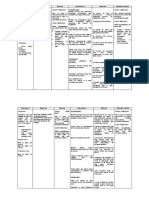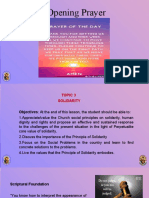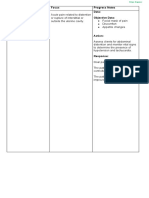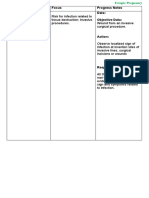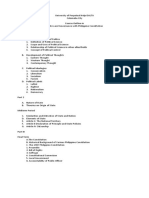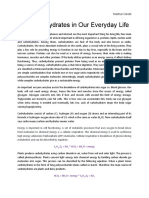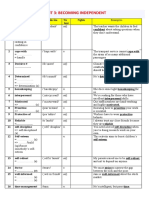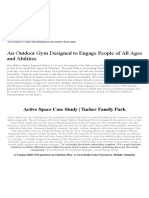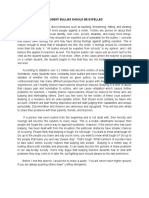Professional Documents
Culture Documents
Eval Exam Psych Alviz
Eval Exam Psych Alviz
Uploaded by
Matelyn OargaOriginal Description:
Copyright
Available Formats
Share this document
Did you find this document useful?
Is this content inappropriate?
Report this DocumentCopyright:
Available Formats
Eval Exam Psych Alviz
Eval Exam Psych Alviz
Uploaded by
Matelyn OargaCopyright:
Available Formats
* NLE * NCLEX * HAAD * PROMETRICS * DHA * MIDWIFERY * LET * RAD TECH * CRIMINOLOGY * DENTISTRY * PHARMACY * MED TECH
REFRESHER PHASE
EVALUATIVE EXAM
PSYCHIATRIC NURSING
PROF. ARCHIE ALVIZ, RN, RM, MAN, NCII
1. The charge nurse in an acute care setting assigns to 11. A nurse places Paolo, a male client in full leather restraints.
Lemuel, a male client, who’s on one-to-one suicide How often must the nurse check the client’s circulation?
precautions, to a psychiatric aide. This assignment is A. Once per hour.
considered: B. Once per 8-hour shift.
A. Poor nursing practice because a registered nurse C. Every 15 minutes.
should work with this client. D. Every 2 hours.
B. Reasonable nursing practice because one-to-one
supervision requires the total attention of a staff 12. Marco, an adult client in an acute care mental health
member. program refuses his morning dose of an oral antipsychotic
C. Outside the responsibility of an aide. medication and believes he’s being poisoned. The nurse should
D. Illegal to delegate to an aide. respond by taking which action?
A. Administering the medication by injection.
2. What’s a nurse most important role in caring for Fernando, B. Omitting the dose and trying again the next day.
an adult client with a mental disorder? C. Crushing the medication and putting it in his food.
A. To offer advice D. Consulting with the physician about a care plan.
B. To know how to solve the client’s problem
C. To establish trust and rapport 13. A nurse is working with Helen, a female dying client and
D. To set limits with the client her family. Which communication technique is most important
to use?
3. Unhealthy personal boundaries are a product of A. Reflection
dysfunctional families and a lack of positive role models. B. Interpretation
Unhealthy boundaries may also be a result of: C. Clarification
A. Structured limit setting D. Active listening
B. A supportive environment
C. Abuse and neglect 14. The nurse is aware that the goal of crisis intervention is:
D. Direction and attention A. To solve the client’s problems for him.
B. Psychological resolution of the immediate crisis.
4. The nurse in-charge is displaying assertive behavior when C. To establish a means for long-term therapy.
she: D. To provide a means for admission to an acute care
A. Says what’s on her mind at the expense of others. facility.
B. Expresses an air of superiority.
C. Avoids unpleasant situations and circumstances. 15. Toni, a male client in a group therapy is restless. His face
D. Stands up for her rights while respecting the rights of is flushed and he makes sarcastic remarks to group members.
others. The nurse responds by saying, “You look angry.” The nurse is
using which technique?
5. In a group therapy setting, Aj, a male member is very A. A broad opening statement
demanding, repeatedly interrupting others and taking most of B. Reassurance
the group time. The nurse’s best response would be: C. Clarifying
A. “Will you briefly summarize your point because others D. Making observations
need time also?”
B. “Your behavior is obnoxious and drains the group.” 16. Sonny, a male patient with antisocial personality disorder
C. To ignore the behavior and allow him vent smokes where it is prohibited and refuses to follow other unit
D. “I’m so frustrated with your behavior.” and hospital rules. The patient gets others to do the laundry
and other personal chores, splits the staff, and will work only
9. The nurse is aware that the primary indication for the use of with certain nurses. The plan of care for this patient should
electroconvulsive therapy (ECT) is: focus primarily on:
A. Severe agitation A. A consistently enforcing unit rules and hospital policy.
B. Antisocial behavior B. Isolating the patient to decrease contact with easily
C. Noncompliance with treatment manipulated patients.
D. Major depression with psychotic features C. Engaging in power struggles with the patient to
minimize manipulative behavior.
10. The employer of Sitti, a female client on the psychiatric D. Using behavior modification to decrease negative
unit calls the nursing station inquiring about the client’s behavior by using negative reinforcement.
progress. The nurse doesn’t know if consent has been given by
the client to allow the staff to give information out to caller on 17. The nurse knows that the doctor in charge has ordered the
the phone. Which response by the nurse would be best? liquid form of the drug chlorpromazine rather than the tablet
A. “I’m not permitted to discuss her progress.” form because the liquid?
B. “I’ll give you the name and telephone number of her A. Has a more predictable onset of action
physician.” B. Produces fewer anticholinergic effects
C. “I’ll have her call you.” C. Produces fewer drug infections
D. “I can’t confirm whether your employee is a client D. Has a longer duration of action
here.”
TOP RANK REVIEW ACADEMY, INC. Page 1 | 3
18. Grover, a male patient receiving fluphenazine (Prolixen) C. Regression
therapy develops pseudoparkinsonism. The doctor is likely to D. Conversion
prescribe which drug to control this extrapyramidal effect?
A. Phenytoin (Dilantin) 26. Haran, a client has approached the nurse asking for advice
B. Amantadine (Symmetrel) on how to deal with his alcohol addiction. The nurse should tell
C. Benztropine (Cogentin) the client that the only effective treatment for alcoholism is:
D. Diphenhydramine A. psychotherapy.
B. total abstinence.
19. During a panic attack, Hero, a male patient runs to the C. Alcoholics Anonymous (AA).
nurse and reports breathing difficulty, chest pain, and D. aversion therapy.
palpitations. The patient is pale, with the mouth wide open and
eyebrows raised. What should the nurse do first? 27. The nurse is providing care for Mer, a client undergoing
A. Assist the patient to breath deeply into a paper bag. opiate withdrawal. Opiate withdrawal causes severe physical
B. Orient the patient to person, place and time. discomfort and can be life-threatening. To minimize these
C. Set limits for acting out delusional behaviors. effects, opiate users are commonly detoxified with:
D. Administer an I.M. anxiolytic agent. A. barbiturates.
B. amphetamines.
20. Dingdong and Marian, a husband and wife seek emergency C. methadone.
crisis intervention because he slapped her repeatedly the night D. benzodiazepines.
before. The husband says he grew up in a household where
his father frequently abused both his mother and him. When 28. The nurse is caring for Sheryl, a client who experiences
interviewing with this couple, the nurse in charge knows they false sensory perceptions with no basis in reality. These
are at risk for repeated violence because the husband: perceptions are known as:
A. Has only moderate impulse control. A. delusions.
B. Denies feelings of jealousy or possessiveness. B. hallucinations.
C. Has learned violence as an acceptable behavior. C. loose associations.
D. Feels secure in his relationship with his wife. D. neologisms.
21. What occurs during the working phase of the nurse-patient 29. The nurse is caring for Rachel, a client who is suicidal.
relationship? When accompanying the client to the bathroom, the nurse
A. The nurse assesses the patient’s needs and develops should:
a plan of care. A. give him privacy in the bathroom.
B. The nurse and patient together evaluate and modify B. allow him to shave.
the goals of the relationship. C. open the window and allow him to get some fresh air.
C. The nurse and patient discuss their feelings about D. observe him.
terminating the relationship.
D. The nurse and patient explore each other’s 30. The nurse is developing a care plan for Medusa, a client
expectations of the relationship. with anorexia nervosa. Which action should the nurse include
in the plan?
22. When caring for Martin, a male adolescent patient A. Restrict visits with the family until the client begins to
diagnosed with depression, the nurse should remember that eat.
depression manifests differently in adolescents and adult. In an B. Provide privacy during meals.
adolescent, signs and symptoms of depression are likely to C. Set up a strict eating plan for the client.
include: D. Encourage the client to exercise, which will reduce
A. Helplessness, hopelessness, hypersomnolence, and her anxiety.
anorexia.
B. Truancy, a change of friends, social withdrawal, and 31. Rochelle, a client whose husband recently left her is
oppositional behavior. admitted to the hospital with severe depression. The nurse
C. Curfew breaking, stealing from family members, suspects that the client is at risk for suicide. Which of the
truancy, and oppositional behavior. following questions would be most appropriate and helpful for
D. Hypersomnolence, obsession with body image, and the nurse to ask during an assessment for suicide risk?
valuing of peer’s opinion. A. "Are you sure you want to kill yourself?"
B. "I know if my husband left me, I'd want to kill myself.
23. During the admission assessment, Andre, a male patient Is that what you think?"
with a panic disorder begins to hyperventilate and says, “I’m C. "How do you think you would kill yourself?"
going to die if I don’t get out of here right now!” What is the D. "Why don't you just look at the positives in your life?"
nurse’s best response?
A. “Just calm down. You’re getting overly anxious.” 32. The nurse is caring for Carlo, a client who she believes has
B. “What do you think is causing your panic attack?” been abusing opiates. Assessment findings in a client abusing
C. “You can rest alone in your room until you feel opiates, such as morphine, include:
better.” A. dilated pupils and slurred speech.
D. “You’re having panic attack. I’ll stay here with you.” B. rapid speech and agitation.
C. dilated pupils and agitation.
24. Barbie, a female patient with a conversion disorder who D. euphoria and constricted pupils.
reports blindness, ophthalmologic examinations reveal that no
organic disorder is causing progressive vision loss. The most 33. The nurse is caring for Marvin, a client experiencing an
likely source of this patient’s blindness is: anxiety attack. Appropriate nursing interventions include:
A. A family history of major depression. A. turning on the lights and opening the windows so that
B. Having been forced to watch a loved one’s torture. the client doesn't feel crowded.
C. Noncompliance with a psychotropic medication B. leaving the client alone.
regimen. C. staying with the client and speaking in short
D. Daily use of antianxiety agents and alcoholic sentences.
beverages. D. turning on stereo music.
25. Mirriam, a busy attorney with a successful law practice is 34. The nurse is teaching a new group of mental health aides.
admitted to an acute care facility with epigastric pain. Since The nurse should teach the aides that setting limits is most
admission, the patient has called the nurse 15 minutes with important for:
one request or another. This patient is exhibiting: A. a depressed client.
A. Repression B. a manic client.
B. Somatization C. a suicidal client.
TOP RANK REVIEW ACADEMY, INC. Page 2 | 3
D. an anxious client. 44. The nurse is caring for Ramon, a 40-year-old client. Which
behavior by the client indicates adult cognitive development?
35. Catherine, a client is admitted with a diagnosis of delusions A. Has perceptions based on reality
of grandeur. This diagnosis reflects a belief that one is: B. Assumes responsibility for actions
A. highly important or famous. C. Generates new levels of awareness
B. being persecuted. D. Has maximum ability to solve problems and learn new
C. connected to events unrelated to oneself. skills
D. responsible for the evil in the world.
45. The nurse is assessing Wally, a client suffering from stress
36. The nurse is caring for Yong, a client, a Vietnam veteran, and anxiety. A common physiological response to stress and
who exhibits signs and symptoms of posttraumatic stress anxiety is:
disorder. Signs and symptoms of posttraumatic stress disorder A. sedation.
include: B. diarrhea.
A. hyperalertness and sleep disturbances. C. vertigo.
B. memory loss of traumatic event and somatic distress. D. urticaria.
C. feelings of hostility and violent behavior.
D. sudden behavioral changes and anorexia. 46. The nurse is assessing a client for lifestyle factors that
might affect normal coping. Which factor would the nurse most
37. The nurse is caring for Luis, a client with manic depression. likely consider?
The care plan for a client in a manic state would include: A. Inadequate diet
A. offering high-calorie meals and strongly encouraging B. Divorce
the client to finish all food. C. Job promotion
B. insisting that the client remain active throughout the D. Adopting a child
day so that he'll sleep at night.
C. allowing the client to exhibit hyperactive, demanding, 47. Bill, a client with bipolar disorder is being treated with
manipulative behavior without setting limits. lithium for the first time. The nurse should observe the client
D. listening attentively with a neutral attitude and for which common adverse effect of lithium?
avoiding power struggles. A. Sexual dysfunction
B. Constipation
38. Nico, a client is admitted for detoxification after a cocaine C. Polyuria
overdose. The client tells the nurse that he frequently uses D. Seizures
cocaine but that he can control his use if he chooses. Which
coping mechanism is he using? 48. Nonoy, a client is admitted for an overdose of
A. Withdrawal amphetamines. When assessing this client, the nurse should
B. Logical thinking expect to see:
C. Repression A. tension and irritability.
D. Denial B. slow pulse.
C. hypotension.
39. Femie, a 23-year-old client is diagnosed with dependent D. constipation.
personality disorder. Which behavior is most likely evidence of
ineffective individual coping? 49. During a shift report, the nurse learns that she'll be
A. Inability to make choices and decisions without advice providing care for Ninoy, a client who is vulnerable to panic
B. Showing interest only in solitary activities attack. Treatment for panic attacks includes behavioral
C. Avoiding developing relationships therapy, supportive psychotherapy, and medication such as:
D. Recurrent self-destructive behavior with history of A. barbiturates.
depression B. antianxiety drugs.
C. depressants.
40. Winnie, a 40-year-old client is admitted for alcohol D. amphetamines.
withdrawal. The most common early sign or symptom that this
client is likely to experience is: 50. Cory, a client comes to the emergency department while
A. impending coma. experiencing a panic attack. The nurse can best respond to a
B. manipulating behavior. client having a panic attack by:
C. suppression. A. staying with the client until the attack subsides.
D. perceptual disorders. B. telling the client everything is under control.
C. telling the client to lie down and rest.
41. Narciso, a client is admitted with a diagnosis of schizotypal D. talking continually to the client by explaining what's
personality disorder. Which signs would this client exhibit happening.
during social situations?
A. Aggressive behavior
B. Paranoid thoughts
C. Emotional affect
D. Independence needs
42. The nurse is caring for Shakira, a client in an acute manic
state. What's the most effective nursing action for this client?
A. Assigning him to group activities.
B. Reducing his stimulation.
C. Assisting him with self-care.
D. Helping him express his feelings.
43. The nurse is caring for Sarah, a client diagnosed with
bulimia. The most appropriate initial goal for a client diagnosed
with bulimia is to:
A. avoid shopping for large amounts of food.
B. control eating impulses.
C. identify anxiety-causing situations.
D. eat only three meals per day.
TOP RANK REVIEW ACADEMY, INC. Page 3 | 3
You might also like
- Ratio Preboard 1 NP 1 IntensiveDocument10 pagesRatio Preboard 1 NP 1 IntensiveKonstantin Konstantius50% (2)
- Post Test Funda KeyDocument8 pagesPost Test Funda KeyJenny Agustin FabrosNo ratings yet
- NP IiDocument11 pagesNP IiOlivia LowellNo ratings yet
- Accomplishments Report Virtual GraduationDocument4 pagesAccomplishments Report Virtual GraduationKezha Louise Cudal Makinano100% (6)
- 61e1a14b1ceb4 PB3-NP5-STUDENTDocument9 pages61e1a14b1ceb4 PB3-NP5-STUDENTKevin PatrickNo ratings yet
- Date Focus Progress Notes Data: Subjective Data:: Ectopic PregnancyDocument1 pageDate Focus Progress Notes Data: Subjective Data:: Ectopic PregnancyMatelyn OargaNo ratings yet
- NP1 1Document13 pagesNP1 1Lyca Berin100% (1)
- Refresher Course: Preboard Examination Nursing Practice I: Basic Foundation of Nursing and Professional PracticeDocument9 pagesRefresher Course: Preboard Examination Nursing Practice I: Basic Foundation of Nursing and Professional PracticeKristine SingsonNo ratings yet
- Ratio Psych Part 1 Pre FCDocument17 pagesRatio Psych Part 1 Pre FCKonstantin Konstantius100% (1)
- Ratio R2 NP 1Document16 pagesRatio R2 NP 1Konstantin Konstantius100% (4)
- Refresher Course: Preboard ExaminationDocument6 pagesRefresher Course: Preboard ExaminationJastine Sabornido0% (1)
- Refresher Course: Preboard Examination Nursing Practice IV: Care of Clients With Physiologic and Psychosocial Alterations (Part B)Document7 pagesRefresher Course: Preboard Examination Nursing Practice IV: Care of Clients With Physiologic and Psychosocial Alterations (Part B)Jastine Sabornido0% (2)
- Psyche Arzadon Ans Key DrillsDocument11 pagesPsyche Arzadon Ans Key Drillsjon elle100% (1)
- Preschool Key Developmental Indicators ChartDocument1 pagePreschool Key Developmental Indicators Chartapi-375217674No ratings yet
- Revised OB Handout Part 1 MAY 2023 PNLE RefresherDocument15 pagesRevised OB Handout Part 1 MAY 2023 PNLE RefresherMatelyn OargaNo ratings yet
- Recalls 1 Exam Nursing Practice 1: Name: Date: SCOREDocument7 pagesRecalls 1 Exam Nursing Practice 1: Name: Date: SCOREWILMAR DEL MONTE50% (2)
- Toprank Midterms Post TestDocument79 pagesToprank Midterms Post TestTony ReyesNo ratings yet
- Final Coaching: Fundamentals of NursingDocument16 pagesFinal Coaching: Fundamentals of NursingMicaila MacyNo ratings yet
- Upang Nursing PsychDocument8 pagesUpang Nursing PsychRamon Carlo Almiranez100% (4)
- PSYCHE Mental Health Concepts N2018 Ans KeyDocument5 pagesPSYCHE Mental Health Concepts N2018 Ans KeyJo Hn Vengz100% (1)
- FC - Pysche 06-17-21 Sir LintaoDocument16 pagesFC - Pysche 06-17-21 Sir LintaoCherry Gabane100% (1)
- POST TEST FUNDA - StudentDocument4 pagesPOST TEST FUNDA - StudentNur Fatima SanaaniNo ratings yet
- ERDNDocument128 pagesERDNJohiarra TabigneNo ratings yet
- Posttest Ans Key Intensive Onco de GuzmanDocument2 pagesPosttest Ans Key Intensive Onco de GuzmanZymer Lee AbasoloNo ratings yet
- Post-Test GIT: Prepared By: Prof. EJ FlaminianoDocument5 pagesPost-Test GIT: Prepared By: Prof. EJ FlaminianoKristele Joy Bagarino - Raralio0% (1)
- Respi HemaDocument57 pagesRespi Hemaniczdelosreyes8No ratings yet
- Post Test Ob ArzadonDocument2 pagesPost Test Ob ArzadonMatelyn OargaNo ratings yet
- OB-2-SIR-KEN LDocument5 pagesOB-2-SIR-KEN LLyrechel de GuzmanNo ratings yet
- CODE OF ETHICS FOR RNsDocument3 pagesCODE OF ETHICS FOR RNschaeyash xxNo ratings yet
- Posttest Ans Key Intensive Onco de GuzmanDocument2 pagesPosttest Ans Key Intensive Onco de GuzmanZymer Lee AbasoloNo ratings yet
- COVID CONCEPTS - CBQ - Dr. GragedaDocument4 pagesCOVID CONCEPTS - CBQ - Dr. GragedaKonstantin KonstantiusNo ratings yet
- NP2 Recalls 9Document10 pagesNP2 Recalls 9AhrisJeannine EscuadroNo ratings yet
- SC PT PediaDocument3 pagesSC PT PediaMatelyn OargaNo ratings yet
- Git OnlineDocument82 pagesGit OnlineCarl JustineNo ratings yet
- NP1 - ToprankDocument16 pagesNP1 - ToprankAllaiza Cristille100% (1)
- Refresher Course: Preboard Examination Nursing Practice III: Care of Clients With Physiologic and Psychosocial Alterations (Part A)Document9 pagesRefresher Course: Preboard Examination Nursing Practice III: Care of Clients With Physiologic and Psychosocial Alterations (Part A)Jastine Sabornido0% (1)
- Ratio Preboard 1 NP 2 IntensiveDocument10 pagesRatio Preboard 1 NP 2 IntensiveKonstantin KonstantiusNo ratings yet
- POST TEST CHN PROF. DACLIS SC .Docx 1Document10 pagesPOST TEST CHN PROF. DACLIS SC .Docx 1pasabay270No ratings yet
- Post-Test Neurologic Nursing: Prepared By: Prof. EJ FlaminianoDocument2 pagesPost-Test Neurologic Nursing: Prepared By: Prof. EJ FlaminianoAl SerrocoNo ratings yet
- Take One Nursing Final Coaching Ms CriticalDocument29 pagesTake One Nursing Final Coaching Ms Criticalnot your medz duranNo ratings yet
- Refresher Course: Preboard Examination Nursing Practice II: Community Health Nursing and Care of The Mother and ChildDocument8 pagesRefresher Course: Preboard Examination Nursing Practice II: Community Health Nursing and Care of The Mother and ChildJastine Sabornido0% (2)
- FC - CDDocument27 pagesFC - CDCake ManNo ratings yet
- Without Anskey-Ms RF, Ortho, Neuro - DrillsDocument13 pagesWithout Anskey-Ms RF, Ortho, Neuro - Drillsjon elleNo ratings yet
- Post Test Oncology: Philippine Nursing Licensure ExaminationDocument7 pagesPost Test Oncology: Philippine Nursing Licensure ExaminationJohn kananamanNo ratings yet
- Post Test - Ob - Prof. Arzadon (SC)Document2 pagesPost Test - Ob - Prof. Arzadon (SC)Kristen FajilanNo ratings yet
- Medical Surgical Nursing Exam 2Document11 pagesMedical Surgical Nursing Exam 2Zymer Lee AbasoloNo ratings yet
- Preboards 3 Nursing Practice 2 Nov 2021 PDFDocument12 pagesPreboards 3 Nursing Practice 2 Nov 2021 PDFBanana Q0% (1)
- MS PALMERvukoDocument33 pagesMS PALMERvukoEmeroot Root100% (1)
- NP3 PDFDocument17 pagesNP3 PDFKristine Singson100% (1)
- Ca ProfadDocument7 pagesCa ProfadKonstantin Konstantius100% (1)
- Ratio Psych Part 2 Pre FCDocument16 pagesRatio Psych Part 2 Pre FCKonstantin Konstantius0% (1)
- MCN Reviewer ToprankDocument11 pagesMCN Reviewer ToprankAllaiza Cristille100% (1)
- Post Test - ImmunologyDocument25 pagesPost Test - ImmunologyAugusto CamanoNo ratings yet
- 4 Tra - Communicable Disease NursingDocument44 pages4 Tra - Communicable Disease NursingJoshua Delantar100% (1)
- NP 5Document26 pagesNP 5Allaiza CristilleNo ratings yet
- Nursing Test 2 (NP Ii)Document7 pagesNursing Test 2 (NP Ii)Yuxin LiuNo ratings yet
- PROF AD POST TEST AnswersDocument14 pagesPROF AD POST TEST AnswersRika MaeNo ratings yet
- NP2Document12 pagesNP2mhamaenphapa27100% (2)
- Communicable Disease QuestionsDocument51 pagesCommunicable Disease QuestionsHoney Lyn AlebioNo ratings yet
- Final Coaching - Primary Health Care - StudentDocument13 pagesFinal Coaching - Primary Health Care - StudentAshley Ann FloresNo ratings yet
- Posttest GeriaDocument7 pagesPosttest GeriaJohn Lyndon SayongNo ratings yet
- Ratio Pre FC MS Part 1Document15 pagesRatio Pre FC MS Part 1Konstantin KonstantiusNo ratings yet
- PALMDocument21 pagesPALMGiovanni Enrile100% (1)
- T 2 - Unit Test 2 - Psych & PediaDocument8 pagesT 2 - Unit Test 2 - Psych & PediaenzoNo ratings yet
- Ncpdrug ElectroDocument24 pagesNcpdrug ElectroMatelyn OargaNo ratings yet
- BSN GRP2 Benefits and Challenges of Online Class For PrintingDocument85 pagesBSN GRP2 Benefits and Challenges of Online Class For PrintingMatelyn OargaNo ratings yet
- SC PT PediaDocument3 pagesSC PT PediaMatelyn OargaNo ratings yet
- FINAL BSN Depression Among Students During Quarantine PRELIMINARIESDocument6 pagesFINAL BSN Depression Among Students During Quarantine PRELIMINARIESMatelyn OargaNo ratings yet
- BSN GRP2 Benefits and Challenges of Online ClassDocument73 pagesBSN GRP2 Benefits and Challenges of Online ClassMatelyn OargaNo ratings yet
- Final Draft of Guidelines Fees and Reminders For CommencementDocument2 pagesFinal Draft of Guidelines Fees and Reminders For CommencementMatelyn OargaNo ratings yet
- Quiz 2Document5 pagesQuiz 2Matelyn OargaNo ratings yet
- Post Test Ob ArzadonDocument2 pagesPost Test Ob ArzadonMatelyn OargaNo ratings yet
- Revised OB Handout Part 2 MAY 2023 PNLE RefresherDocument9 pagesRevised OB Handout Part 2 MAY 2023 PNLE RefresherMatelyn OargaNo ratings yet
- Health HX and Physical Exam Quiz 1 (OARGA)Document5 pagesHealth HX and Physical Exam Quiz 1 (OARGA)Matelyn OargaNo ratings yet
- FCL 7 Midterm Topic 3 PPT Edited 01Document29 pagesFCL 7 Midterm Topic 3 PPT Edited 01Matelyn OargaNo ratings yet
- Monocyte: FunctionDocument9 pagesMonocyte: FunctionMatelyn OargaNo ratings yet
- Ob 50 Items Evaluation For May 2023 Pnle RefresherDocument7 pagesOb 50 Items Evaluation For May 2023 Pnle RefresherMatelyn Oarga100% (1)
- Health Statistics Vital StatisticsDocument2 pagesHealth Statistics Vital StatisticsMatelyn OargaNo ratings yet
- Date Focus Progress Notes Data: Objective DataDocument1 pageDate Focus Progress Notes Data: Objective DataMatelyn OargaNo ratings yet
- Fdar Risk For InfectionDocument1 pageFdar Risk For InfectionMatelyn OargaNo ratings yet
- RIPH MidtermDocument5 pagesRIPH MidtermMatelyn Oarga100% (1)
- Course Outline in Politics and GovernanceDocument1 pageCourse Outline in Politics and GovernanceMatelyn OargaNo ratings yet
- Forms of Community EngagementDocument1 pageForms of Community EngagementMatelyn OargaNo ratings yet
- Assessment Diagnosis Outcomes Interventions Rationale Expected OutcomeDocument1 pageAssessment Diagnosis Outcomes Interventions Rationale Expected OutcomeMatelyn OargaNo ratings yet
- Right-Sided Heart Failure: College of NursingDocument30 pagesRight-Sided Heart Failure: College of NursingMatelyn OargaNo ratings yet
- Playful Nature Daily Agenda SlideDocument57 pagesPlayful Nature Daily Agenda SlideMatelyn OargaNo ratings yet
- Chronology of Events in or Around Rizal's Death CellDocument1 pageChronology of Events in or Around Rizal's Death CellMatelyn OargaNo ratings yet
- Perioperative NursingDocument82 pagesPerioperative NursingMatelyn OargaNo ratings yet
- Planning For Successful AgingDocument11 pagesPlanning For Successful AgingMatelyn OargaNo ratings yet
- Limosilactobacillus Fermentum ATCC-14931Document14 pagesLimosilactobacillus Fermentum ATCC-1493115041168No ratings yet
- College of Industrial TechnologyDocument12 pagesCollege of Industrial TechnologyESCOTO Mark F.No ratings yet
- 1's TabletsDocument46 pages1's TabletsParvathi DeviNo ratings yet
- Carbohydrates in Our Everyday LifeDocument3 pagesCarbohydrates in Our Everyday LifeMadhuri HandeNo ratings yet
- Unit 3: Becoming IndependentDocument2 pagesUnit 3: Becoming IndependentNguyễn Nam AnhNo ratings yet
- Work Method Statement - ACRYLIC EMULSION PAINTDocument2 pagesWork Method Statement - ACRYLIC EMULSION PAINTSathish GowdaNo ratings yet
- Wound Care ThesisDocument4 pagesWound Care Thesiscandacedaiglelafayette100% (2)
- S022 - R04 Service Manual Ec 3890li PDFDocument104 pagesS022 - R04 Service Manual Ec 3890li PDFMiguel DiazNo ratings yet
- Kepner TregoeDocument26 pagesKepner TregoeAnuj GuptaNo ratings yet
- 3 Case Studies in A Park With Playground and Outdoor Fitness GymDocument18 pages3 Case Studies in A Park With Playground and Outdoor Fitness GymTeresa AdralesNo ratings yet
- Quality of Life: Concept and Definition: COPD: Journal of Chronic Obstructive Pulmonary DiseaseDocument10 pagesQuality of Life: Concept and Definition: COPD: Journal of Chronic Obstructive Pulmonary DiseaseKaren SanchezNo ratings yet
- 2.2.14 - QPR-RHT-REG-001 Health Safety and Environment Regulation RevDocument18 pages2.2.14 - QPR-RHT-REG-001 Health Safety and Environment Regulation RevLyle Korytar100% (1)
- Disaster Readiness & Risk Reduction: Quarter 1 - Module 2 Effects of DisasterDocument12 pagesDisaster Readiness & Risk Reduction: Quarter 1 - Module 2 Effects of DisasterKimberly Trocio Kim0% (1)
- Marable v. Marable, G.R. No. 178741 January 17, 2011Document2 pagesMarable v. Marable, G.R. No. 178741 January 17, 2011Gracëëy UyNo ratings yet
- 1982 - Miller Et Al. - The Nasal Smear For Eosinophils. Its Value in Children With Seasonal Allergic RhinitisDocument3 pages1982 - Miller Et Al. - The Nasal Smear For Eosinophils. Its Value in Children With Seasonal Allergic Rhinitispond_1993No ratings yet
- Student Bullies Should Be ExpelledDocument1 pageStudent Bullies Should Be ExpelledAdamier Latip100% (1)
- Objectives: Assessing One'S Pecs: Characteristics, Attributes, Lifestyle, Skills, and TraitsDocument3 pagesObjectives: Assessing One'S Pecs: Characteristics, Attributes, Lifestyle, Skills, and TraitsSherryl ZamonteNo ratings yet
- Complaints Response Mechanism (CRM) How To Make A Complaint Who Can Complain?Document2 pagesComplaints Response Mechanism (CRM) How To Make A Complaint Who Can Complain?Yohannes DessieNo ratings yet
- The Men Are Weeping in The Gym AnalysisDocument4 pagesThe Men Are Weeping in The Gym AnalysislottieNo ratings yet
- Main Rubrics by Design Part 2Document17 pagesMain Rubrics by Design Part 2Czerwin JualesNo ratings yet
- Chapter 3 - Socio-Demographic Characteristics and Average Household Water Consumption - A Behavioral AnalysisDocument4 pagesChapter 3 - Socio-Demographic Characteristics and Average Household Water Consumption - A Behavioral AnalysisElsie PausalNo ratings yet
- Aligood Terjemahan Bagian 6Document21 pagesAligood Terjemahan Bagian 6nurul faizinNo ratings yet
- Annual Implementation Plan: Calendar Year 2021Document5 pagesAnnual Implementation Plan: Calendar Year 2021Guia Marie Diaz BriginoNo ratings yet
- Drug Use and Abuse Canadian 1st Edition Maisto Test BankDocument12 pagesDrug Use and Abuse Canadian 1st Edition Maisto Test Bankkarenyoungsbpmkaxioz100% (16)
- NSTP Group 7 Report ReferenceDocument16 pagesNSTP Group 7 Report Referencecabigting.pennyfrancia.cobspcfNo ratings yet
- Touch YourselfDocument16 pagesTouch Yourselffatmas100% (1)
- NURS 328: Understanding Research: Assignment 1 Facilitating Evidence-Based Practice: Dissemination ProjectDocument11 pagesNURS 328: Understanding Research: Assignment 1 Facilitating Evidence-Based Practice: Dissemination ProjectKuharaj TharmakulasinghamNo ratings yet
- Wma International Code of Medical EthicsDocument4 pagesWma International Code of Medical EthicsRani MesaNo ratings yet


























